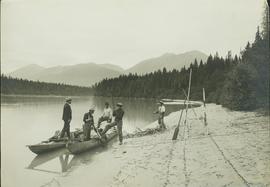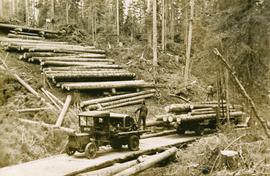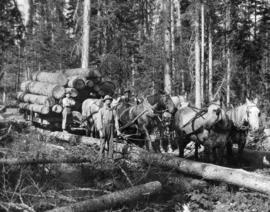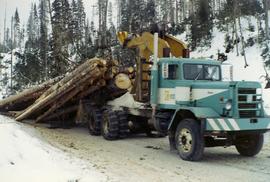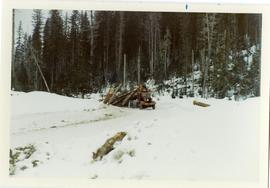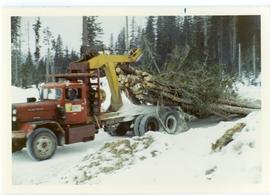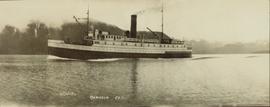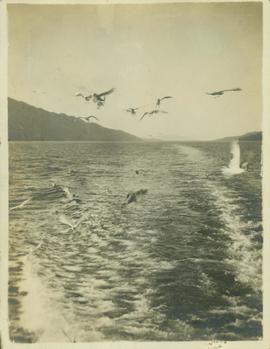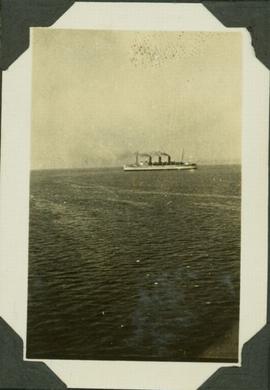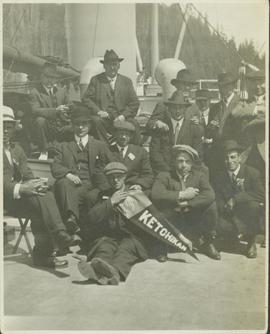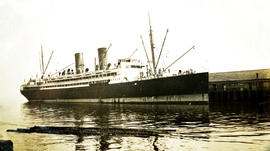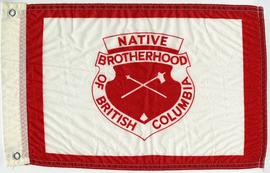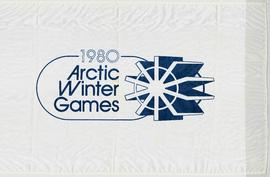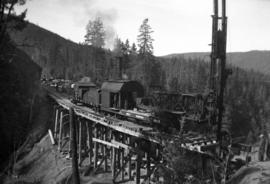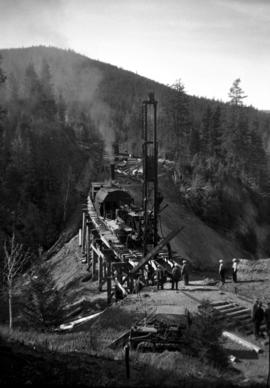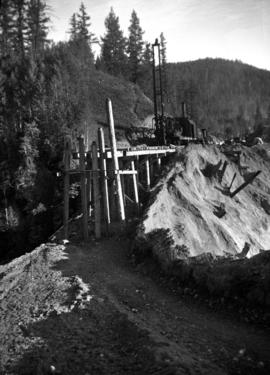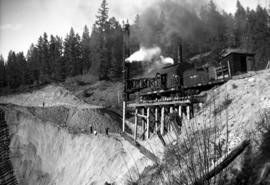File consists of a videocassette (VHS) recording of Mary John & Bridget Moran at the College of New Caledonia, March 12, 1991.
Videocassette Summary
Context: Bridget Moran and Mary John speaking to students at CNC, specific class unidentified.
Introduction: Bridget identifies that she will make the introductory speech and Mary will answer any questions because Mary doesn’t like to make speeches even though she is very good at it. Bridget’s connection with Mary and with Stoney Creek Reserve: Bridget Moran (BM) came to Prince George in 1954 as a social worker and soon after went to the Stoney Creek reserve. At that time the Indian Agent was in control of reserves and social workers were only called on to a reserve if they had to remove a child that was been abused or neglected. The state of reserves was horrible. BM made a promise to her mother that she would at some point do something about the impoverished state of reserves. In 1964 she was suspended by the provincial govt. for speaking out against current social policy. After writing her second published book Judgement at Stoney Creek she met Mary through Mary’s daughter Helen. Helen felt that Mary’s life was typical and yet a bit more significant than the average native woman and so approached Bridget to write a book about her mother’s life. BM put it off due to her busy career in social work. About 1983-84 Mary got sick and BM was afraid she wouldn’t have chance to capture Mary’s life story. So she took her motor home out to Stoney Creek and recorded Mary’s story – Mary beaded, while she knitted and they just talked. Once the book was written, BM’s daughter Roseanne became BM’s agent. After inquest in 1976 she had started 2nd published book Judgement at Stoney Creek but her publishers were not supportive of publishing books about Natives at that time. BM then wrote Stoney Creek Woman (SCW) and published it; after which time Judgement was better received. SCW now recommended in schools. Since publication they have done many talks across the province. Writing SCW was hard but wonderful in that Mary was able to share her feelings with BM. When the book was coming out Mary was very nervous, it came out on Nov. 12, 1988. Mary read the book and was really angry about reliving what had happened to her people. BM talks about thoughts of a 2nd book re: Mary’s thoughts on the environment and her culture. BM gives Mary the floor for questions.
[Note: most student questions were inaudible and so only replies have been noted below]
MJ: She was very upset about the Supreme Court decision. She speaks about how free her people used to be. They could stop and make camp anywhere – this was no longer the case as all is private property. There are greater alcohol problems in north. They are holding workshops in Stoney Creek to help the young people. The older people know what to do, beadwork, etc. the young people don’t like to do traditional tasks, even for cash. The elders try to teach them. She has about 5 boys working doing wood for elders but they have no axe so she had to get one for them They are so poor on reserves. The elders try everything – elders tried a wood processing plant - for 10yrs they studied this. Had people from Switzerland and Germany lined up who wanted the wood but they still didn’t get anywhere.
BM: People are now living better in Stoney Creek. When she first visited a reserve tuberculosis (TB) was rampant. In 1954 so many people had TB and they were all treated away from home. This left people at home (mainly women) to raise the children by themselves. We have social network now that was not existent in ’54. Still compared to the majority of society, reserve conditions are comparable to living conditions in the 3rd world.
MJ: Some reserves like Ft. Ware are just desperate. One night staying in a medical house, a child 10 or 11 was wondering around at night in the rain. When they got up in morning and he came into the centre and had breakfast. They asked him why he was outside all night. He said he was trying to catch horses. This boy was enamored with the cowboy hat and leather jacket another boy there was wearing. This other boy told him he would buy a hat and coat for him when he returned home. By the time the package was sent, the young boy was dead from sniffing gas.
BM: People are depressed and alcohol and drugs is one way to cope
MJ: Men drinking early in morning, she talked to them. One guy hadn’t worked a day in his life. She asked him why he drinking. One guy says he just drinks once and awhile that is wasn’t a problem. The other guy left as didn’t want to hear the truth. She says they need a job – something to live for.
MJ: She tells children to get educated and then come back to the reserve and help their people - like Eddie John and Archie Patrick did. [Discussion on environment]: The Elders group comes together and talks about environment: how the earth is being stripped dry. This worries them. The animals are not there. Years ago, they were so poor, they just had basic food. Their cupboard was in the bush, they were so busy trying to make a living while the men were out logging trying make money. The men logged by hand and the land still looks untouched. That is how they earned a living, and the land is not scarred.
Years ago people were not fearful of sickness, there was no sickness, and there were hardly any accidents as everyone was so used to the bush. The only thing her people feared was starvation. After the 1918 flu many orphans were left. One old lady took them in and had hardly any food herself. In the spring she had a cache in ground she had buried there. She sent 2 children to it to dig it up. When the children brought the supplies back to camp the old woman gave ½ fish to each child. They were like hungry dogs. The elders keep telling people, when hunting/fishing don’t waste anything in fear of starvation. One old lady said they were starving and went into bush and found mouse droppings and even that they cooked. With a moose, you eat all of it, right down to the marrow.
MJ: The elders organized themselves and did workshops to learn how to help their young people. Many deaths among young people.
BM: Suicide rate among natives is 2-3x’s higher than among non-natives
MJ: The elders have tried everything to help with the problems of young people. But the youth drift away as they have no interest.
BM: One of the psychiatrists she talked to said that one of the best preventions for suicide is for kids to have a goal to work towards. Native youth have no goals, no education, no jobs, nothing to look forward to.
MJ: Her daughter doesn’t like to be on welfare. She was searching for job. The Elders gave her a job watching over traps but this had to be shut down due to lack of money for furs. She then put her name in as a janitor for the highschool in Vanderhoof but was turned down. MJ furious because they [the white people] in that school wouldn’t even let her daughter clean up their shit!
BM: Northern communities with large native populations, like Fort St. James or Vanderhoof, rely on the money brought in by the native community; yet most businesses don’t employ natives. The natives have to realize their own economic power.
MJ: The elders started a bingo night and were going to hold a fishing derby. They sent a young man into Vanderhoof to find donations for the derby. He went to the Elks club and was told he’d get nothing there because Stoney Creek took away their bingo night. Her people had supported them [the Vanderhoof bingo night] for years and years before, but as soon as the natives had their own bingo night they were not supporting the one in Vanderhoof anymore.
MJ: She told her husband she was going to PG to talk about the book. He has no problem with it.
BM: Lazare doesn’t read or write.
MJ: He went to school at Lejac for 2 years. Now all he can do is sign his name. It’s sad.
BM: Joanne Fisk just completed PhD, she teaches at Dalhousie but she used to spend summers in Stoney Creek and she did her thesis on Lejac. Her thesis was that residential schools were of some help to girls but were disastrous for boys. The girls learned to read and write; while few boys came out of residential schools who could read or write. All they did was hard work out in the fields. When preparing for Judgement, she spoke with Coreen Thomas’ father. He attended Lejac for 6 years, he was beaten and worked like a horse, and he couldn’t read or write. He cried for 2 hrs when BM told him she was going to write a book about his daughter. Sophie Thomas, however, felt she learned a lot out of Lejac – how to sew, read and write and make bread. Men learned nothing to help them make a living.
MJ: Last fall, there was a conflict between town and reserve children. Vanderhoof citizens didn’t want reserve children attending the town school. It cooled down. The school on reserve only teaches kindergarten, and grades 1-3.
MJ: Her daughter-in-laws, Gracie and Mary are teaching. The elders are going to have a summer camp at Wedgewood fish camp. It is going to be a survival camp.
MJ: They have dancers. They try to revive the language and culture. There aren’t too many storytellers. Selina and Veronica are two elders who are good storytellers. She’s going to try and get hold Veronica and tape one of her stories, she has taped 3 of them already. The elders are training the teachers (of language) and working on dictionaries and some books.
MJ: The population on her people is about 500 and increasing. Most people are out in towns, like Vanderhoof, and PG. There are about 400 people living on reserve but housing is really bad.
MJ: She says her people were trying to get a grant to get money for wood processing. The Swedish people had their own plans. There was a place on reserve with a railroad that was all set up for wood processing but the DIA had a problem with the funding. The band hired a consultant in Burnaby to put their proposal together. The DIA said they would hire Price Waterhouse to study the study the band produced and there it stayed.
MJ: Her son Ernie started logging on the reserve in ’78 or ‘79. He hired boys from the reserve. Somehow DIA got in and said his work was a conflict and that he couldn’t log on reserve. He already had all the heavy equipment. Her son-in-law, a white man, a businessman living on reserve had helped Ernie to get all this machinery. After the DIA came in, they took this logging business away from him, he lost his machinery. He was so desperate, she thought he would commit suicide. He left for Fort St. James. She was so worried. The DIA needed him to sign some papers but a friend they had within the DIA told Ernie not to sign these papers so Ernie ran. Mary was so angry at the DIA she felt ready to kill, she even had a big rock in her hand when the DIA came looking for her son. Her daughter told her not to do it. Ernie refused to sign. He lost all the machinery. That is where the DIA puts us.
BM: CBC did a series after Oka, looking at Natives across the country trying to start businesses, and in every case they were sabotaged. As long as natives are poor and uneducated, a lot of people in DIA have good jobs.
MJ: Reserve stories pretty hard. Her people tried ranching, they had 150 head of cattle. Years ago an Indian agent, a good man, told her to start ranching on reserve. He’d give them so many acres on CP land
– “certificate of possession”. Some people still have CP land and they can do what they like with it, but they can’t sell it.
BM: There are divisions among natives. She was interviewed by reporter to talk about how there wasn’t one cohesive voice speaking for all natives. She said that was hard, and that natives, as with white people, don’t speak with one voice – just look at the Legislature. Different groups among natives? Of course.
MJ: Years ago, one family lived in one house and got along. It is not the same anymore - family separates so much. Children are taken away. When she got married she lived with 3 families in one house. Long ago there would live one clan in one long house and everyone got along.
MJ: In 1970, her people were allowed to send children to catholic schools in town only. The children were not allowed in public schools. So she went to Ottawa to lobby for the freedom to send native children to any schools they want. She talked to Chretian, the then Minister of Education. Since then they have had that freedom.
MJ: Some families have tried everything: Christian schools, public schools. She’s not sure where they are sending children now - public school is a bad influence! (laughs). Families often sendthei children to Christian schools. There is a high drop out rate. She’s not sure why. In public schools children have choice of what to take. Young people are not “with it”. When children graduate…she took some teenage dancers to Missouri one year. She asked these children where they were, and some said USSR and she says they are not “with it”. They didn’t know anything about the country they were in.
BM: Recently she spoke with teachers and found out that 20% of students at PGSS are now native and yet there is not one native teacher. She found in last 5-7 years, more native people have been coming to PG so as to give their children a better education. But the education system isn’t supportive of them and their children go under. There is one native counselor at PGSS - that’s it. Teachers they talked to spoke to Mary about the differences and frustrations they had with the way native children were raised; such as how native children will look at the floor when speaking to teachers and will then get into trouble.
MJ: Children are taught not to look into eyes as this is like a challenge to the person speaking. They must look down at their own feet and humble themselves. That’s a problem. She says they have to trust [the teachers?]. When a native student is in school and having problems, it helps them to be able to talk to another native person.
MJ: Trust is hard with white people.
MJ: As long as there are reserves, people stay on reserves. Natives get lost in society when they go to towns.
MJ: She will go anywhere to get what she needs from the bush. In the bush she feels close to the earth and at home, she doesn’t feel that way in PG.
BM: Mary and her went to Vancouver in the spring of ’89. Mary stayed with her daughter-in-law at UBC and she couldn’t wait to get back to reserve to find something to do!
MJ: She couldn’t do anything, it was just like a chicken coop. You can’t work outside. She would die if had to stay in a place like that.
BM: The chances of native culture surviving is so much better now than it was 30-40 years ago. It came close to dying out. There is now a pride in being native and an interest in being native that wasn’t there when she started in social work. Back then people were almost ashamed of being native.
MJ: She agrees with Bridget. Many times she was ashamed of her food, the way they talked, everything was against us. Many young people she speaks with are coming back to reserves. In the ‘20-‘30s, her sister-in-law married a non-status Indian and from then on felt she was different because she could go to liquor store, etc. She became ashamed to be seen with Indians. She wouldn’t talk to them on street but would accept them in her home.
MJ: In the potlatch system, her sister-in-law is a higher rank than she is. It would cost MJ a lot of money to raise her status within their clan system. Her sister-in-law is a spokes person in their clan but she had to pay for it. She was given a name and a song. She has to look after her behaviour and all that. She asked Mary to make a blanket for her son many years ago. MJ had been watching him and he wasn’t behaving well. Finally she made that blanket but for another person because he wasn’t ready. He has to behave himself.
MJ: Her children would take her clan, not Lazare’s clan. You cannot marry into your own clan – they are like brother and sister, if that is going to happen they have to separate from the clan.
MJ: They are trying to include all young people. They have a white man married to a native girl, who is very active with the elders and he is a drummer now. They are going to initiate them into her clan.
Another one is also very good with elders. His grandfather is pure Indian but married a white women and so lost much native blood. But now he wants to learn all about his culture. She has all his grandfather’s regalia as he had no one to receive it, but she intends on giving it to his grandson.
BM: The culture is still alive at Stoney Creek. Things are still done in the old way. It is sad that the non- native world cannot see this culture alive.
MJ: If you have a problem, you would ask the family in opposite clan to help you. Such as money for a sick child to go to Vancouver for operation. Or with a funeral, like when her daughter Helen died, people helped her. People helped out while she was watching daughter in hospital, then they paid for the funeral. One year later, her clan put up potlatch and paid back all that was done for her family. In the clan system there is always someone to help.
BM: At the potlatch she attended their were clan members that came from all over BC
MJ: No negative things came from publishing this book. Although one doctor, Dr. Mooney said there wasn’t separate wings for whites and natives at the Vanderhoof hospital. But she remembers this as so.
BM: As a social worker she saw separate wings. She only had one negative encounter with Dr. Jolly – a good friend of Mary’s and of the native peoples around Stoney Creek. She went to Nanaimo for a signing and saw Dr. Jolly there. He said he was angry about the book and wanted to know why, if there was racism, didn’t MJ go and talk to someone. BM asked him who MJ would talk to, the Mayor? She explained that when you are repressed you don’t feel you can go and talk to someone in power. He felt Stoney Creek had been so wonderful for him and the knowledge of this racism distressed him. With her second book, nothing bad yet has come out of it, yet she’s heard nothing really out of Vanderhoof. Most people accept that there is racism and take it from there. Going to Vanderfhoof with Mary is like going to Vanderhoof with royalty. Her own reserve is also very proud of her.
MJ: Indian people are very shy and she wondered how her people would react to the book. Everyone who read the book liked it.
BM: 100’s of people told her that after reading the book they just didn’t realize the situation. Mary’s life has then broadened their understanding of what it meant to be native and a native woman.
MJ: She speaks to her sister-in-law or Veronica about the old days and the young people.
MJ: The reserve has a special constable from the Queen Charlottes who comes and visits her all the time. He is native but he is scared of the Carrier people. She tells him he is welcome, and to feel at home. His boss had told him to go from door to door on the reserve to see who’s living there. He doesn’t want to and she tells him not to, unless he’s asked in. His boss came to see her. She told him that plan wasn’t good and he listened.
BM: Mary has a daughter-in-law who is in the RCMP in Ft. St. James.
MJ: She was in Vancouver working in dispatch. She came home, but now she’s in Regina for more training.
MJ: Her people still have the RCMP out for salmon feast every year. They like it better at Wedgewood. She cooks bannock over the fire.
Instructor: Thank you very much.
Clapping from audience.
